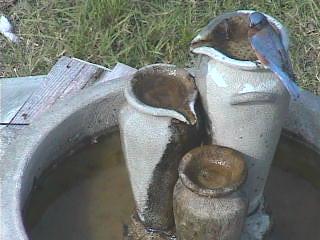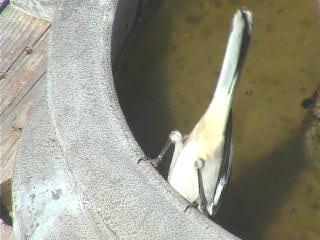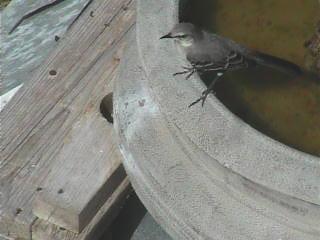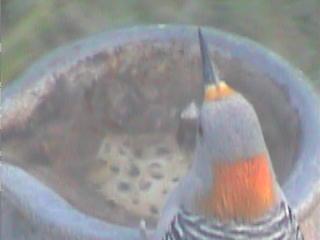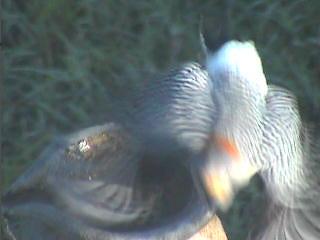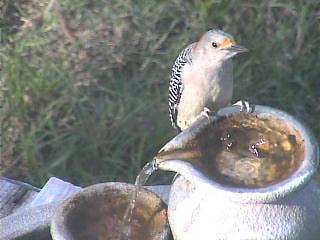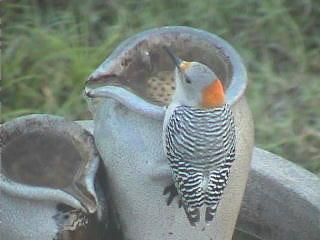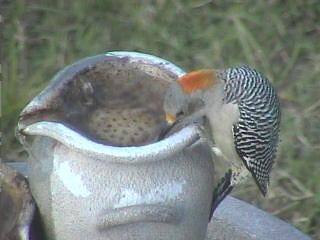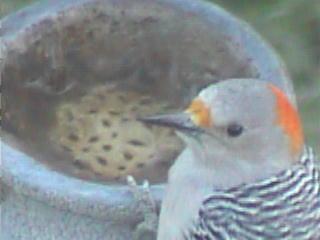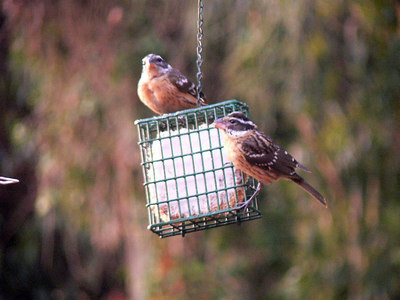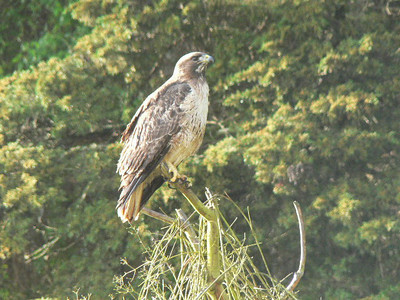Today idbirds and I were chatting about something we’d noticed from time to time: How it apparently is possible to get a view with the camera that is zoomed out farther than is normally allowed. We did some experimenting, and it turns out that it’s pretty easy to trick the system into giving you such a zoomed-out view. Here’s a photo I took when the camera was in what we’ve taken to calling “bonus zoom” mode:
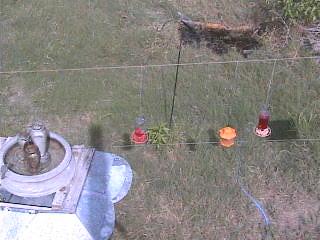
(Update: abirch suggested calling it “wide angle” mode, which I think is probably a better name.)
It seems like this view would be handy in certain circumstances. It helps avoid some of the “tunnel vision” I was talking about in a recent post. You need to be careful with this, since it will tend to make small birds disappear in more-distant views. I’m sure I’m not the only person who’s noticed how smaller birds can seem to vanish when the camera is zoomed out too far, especially when those birds are located far away. That’s why I tend to zoom in a bit when scanning distant locations: There’s no point in looking for birds if you’re zoomed out too far to see them.
To give you a sense of scale, there’s a Golden-fronted Woodpecker visible on the fountain in the lower lefthand corner of that bonus-zoom shot above. It’s pretty tiny, even though it is quite close to the camera. So don’t expect to see small birds in bonus-zoom mode if you’re pointed very far away.
But I think bonus zoom could be useful when looking at a field of view that is relatively close to the camera, waiting for something to fly in that can then be zoomed in on for a closer view. The bonus zoom lets you keep more area under surveillance without having to constantly be panning back and forth. Also, if you could pan while in bonus zoom mode, you could cover the same field of view more quickly, making fewer stops.
There are two parts to this bonus zoom trick that we worked out today:
Trick #1: Getting into bonus zoom mode
This takes two users working together.
The system normally restricts how large a field of view you can request. When drawing a rectangle on the panorama, or when using the minus sign (-) button to expand your most-recent request box, you can’t go past a certain-sized box. (I’ll refer to this normal maximum-zoomed-out view as “max zoom”.)
It turns out, though, that the “game” interface we use to issue requests artificially limits this max zoom. That is, the underlying camera system is capable of zooming out farther than that. In particular, if two users each draw a max-zoom box slightly off-center from each other at roughly the same time, the system will try to accommodate their requests by zooming the camera out a bit more to create a view that encompasses both requests. As long as no one then pulls the camera back by issuing another request, the camera will stay in bonus-zoom mode.
The specific way we accomplished this today was this: One user would start drawing max-zoom requests on the panorama, centering those requests on the red hummingbird feeder to the left of and slightly above the fountain. (There’s nothing magic about that location, but it made for a convenient landmark as we coordinated in chat.) At the same time, the second user started drawing max-zoom requests that were centered about halfway between the hummingbird feeder and the upper-righthand corner of the first user’s request box.
In other words, the second user’s request box was positioned in such a way that its upper righthand corner was above and to the right of the first request box by an amount about half the size of a normal max-zoom box. In still other words, the finished bonus-sized box ended up being about 50% larger than a normal max-zoom box. From the small amount of experimenting we did today, it looks like that’s about as big a box as we can make. When we tried to make a larger bonus-zoom box, the trick didn’t work. That probably reflects a hard limit in the camera’s underlying control system.
The trickiest part of this is knowing when to stop drawing boxes. If you watch the panorama carefully, you can see when the camera creates a bold box representing bonus-zoom mode. Once you see that, it’s important that you stop issuing requests. If you (or another user) draws another request after that, the view will shrink back to that size, dropping you out of bonus-zoom mode.
It seems to work best having just two users do this trick. When we tried it with a third user, we ran into problems, since the chances increased that a late request would drop us back out of bonus zoom after we’d achieved it.
Trick #2: Maintaining and restoring bonus zoom
As you can see, it’s a little bit of work getting into bonus zoom. Also, once you’re in it, you can’t issue another request (zooming or panning) without dropping the camera back to a normal view. But we figured out the following trick: If, once the camera is in bonus-zoom mode, you leave the game and immediately return, as you arrive you will be given a default black request rectangle that is equal to the camera’s current view. In other words, you’ll get a request rectangle that is bonus-zoom sized.
This is really useful. If you draw a rectangle on the panorama, or use the zoom buttons (+/-), you’ll get a normal-sized request box, and lose your bonus-zoom request box. But as long as you limit yourself to using only the arrow keys on the camera controls (up, down, left, right), you can drive the bonus-zoom request box wherever you want. In other words, you can pan around the panorama in bonus-zoom mode.
Besides being able to pan in bonus-zoom mode, there’s another advantage to getting a bonus-sized request box. If a bird appears, and some other user zooms in on it, you will keep your bonus-sized request box. As long as you don’t issue any other pointing requests, you can easily restore the bonus-zoom mode afterward by nudging your request box with the arrow keys.
Did you follow that? Once you get into bonus-zoom mode using trick #1, one or more users can then obtain a bonus-zoom sized request box using trick #2. They can then pan around in bonus-zoom mode using the arrow keys, and, if a bird is seen and the camera is zoomed in by another user, they can return the camera to bonus-zoom mode afterwards by nudging the arrow keys.


